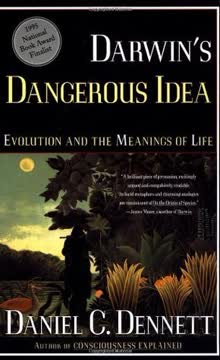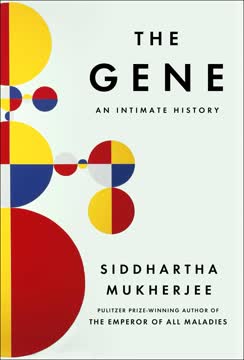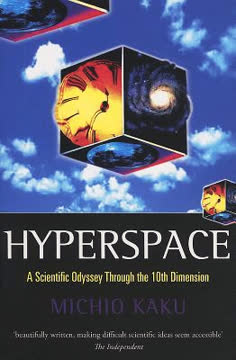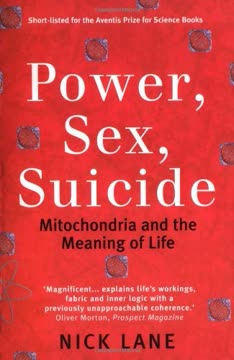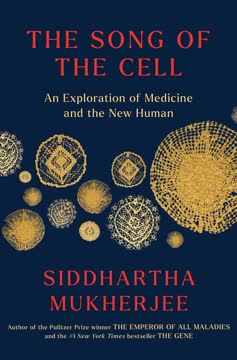نکات کلیدی
1. ژنوم ما کتابی از زندگی است که به زبان دیجیتال نوشته شده است
ژنوم انسان کتابی است ... این کتاب شامل بیست و سه فصل است که به آنها کروموزوم میگویند. هر فصل شامل چندین هزار داستان است که به آنها ژن میگویند.
زبان دیجیتال زندگی. ژنوم اساساً یک سیستم اطلاعاتی است که در الفبای چهار حرفی DNA (A، C، G، T) رمزگذاری شده است. این کد دیجیتال شامل دستورالعملهایی برای ساخت و عملکرد یک انسان است. ساختار ژنوم شبیه به یک کتاب است:
- 23 کروموزوم ("فصلها")
- 20,000-25,000 ژن ("داستانها")
- 3 میلیارد جفت باز DNA ("حروف")
مانند کد کامپیوتری، ژنوم میتواند خوانده، کپی و حتی ویرایش شود. این ماهیت دیجیتال امکان تکثیر دقیق و انتقال اطلاعات ژنتیکی را در نسلها فراهم میکند.
2. ما با تمام موجودات زنده یک نیای مشترک داریم
مگسها و انسانها تنها تغییراتی بر روی یک الگوی ساخت بدن هستند که در موجودی کرممانند در دوره کامبرین شکل گرفته است.
وحدت زندگی. تمام زندگی روی زمین یک نیای مشترک دارد و از همان کد ژنتیکی استفاده میکند. این توضیح میدهد که چرا:
- بسیاری از ژنها در گونههای بسیار متفاوت حفظ شدهاند
- میتوانیم با مطالعه مگسهای میوه یا موشها درباره زیستشناسی انسان بیاموزیم
- مهندسی ژنتیک میتواند ژنها را بین گونهها منتقل کند
شباهتهای مکانیزمهای ژنتیکی در میان اشکال زندگی شواهد قانعکنندهای برای تکامل و ارتباط عمیق ما با تمام موجودات زنده ارائه میدهد.
3. ژنها فقط برای بیماریها نیستند، بلکه زیستشناسی کامل ما را شکل میدهند
ژنها برای ایجاد بیماریها وجود ندارند.
ژنها به عنوان دستورالعملها. در حالی که اغلب بر روی جهشهای بیماریزا تمرکز میکنیم، ژنها عمدتاً دستورالعملهایی برای عملکردهای زیستی طبیعی رمزگذاری میکنند:
- ساخت و نگهداری بدن ما
- تنظیم فرآیندهای فیزیولوژیکی
- تأثیر بر رفتار و ویژگیهای شناختی
ژنهای مرتبط با بیماریها معمولاً نمایانگر واریانتهای ژنهای طبیعی هستند که دارای عملکردهای اساسی هستند. درک این عملکردهای طبیعی برای پیشرفت زیستشناسی و پزشکی حیاتی است.
4. طبیعت و تربیت به روشهای پیچیدهای بر ویژگیهای ما تأثیر میگذارند
دور از اینکه ما در اختیار ژنهای قدرتمند خود باشیم، اغلب این ژنهای ما هستند که در اختیار ما قرار دارند.
تعامل ژن و محیط. ویژگیهای ما نتیجه تعاملات پیچیده بین ژنها و محیط است:
- ژنها میتوانند بر نحوه واکنش ما به عوامل محیطی تأثیر بگذارند
- عوامل محیطی میتوانند بر بیان ژن تأثیر بگذارند
- برخی ژنها بر تمایل ما به جستجوی محیطهای خاص تأثیر میگذارند
این تعامل به این معناست که نه ژنها و نه محیط به تنهایی سرنوشت ما را تعیین نمیکنند. درک این تعاملات کلید گشودن پیچیدگیهای زیستشناسی و رفتار انسانی است.
5. ژنوم انسان حاوی بقایای گذشته تکاملی ما است
ما پر از زنجیرههای دیجیتال و هشدارهایی درباره مارمالاد هستیم.
فسیلهای ژنومی. ژنوم ما یک سند تاریخی است که شامل:
- بقایای ویروسهای باستانی
- ژنهای تکراری
- عناصر DNA "خودخواه" که خود را تکثیر میکنند
این فسیلهای ژنومی بینشهایی درباره تاریخ تکاملی ما و ماهیت پویا ژنومها ارائه میدهند. آنها همچنین نشان میدهند که همه DNAها هدف عملکردی فعلی ندارند.
6. دانش ژنتیکی هم وعده و هم چالشهای اخلاقی به همراه دارد
جای تعجب نیست که در آمریکا شرکتهای بیمه سلامت در حال حاضر به آزمایشهای ژنتیکی برای آلزایمر، بیماریای که میتواند برای آنها بسیار پرهزینه باشد، علاقه نشان میدهند.
شمشیر دو لبه. پیشرفتهای دانش ژنتیکی پتانسیل بزرگی برای پزشکی ارائه میدهند اما همچنین نگرانیهای اخلاقی را برمیانگیزند:
- پتانسیل برای پزشکی شخصیسازی شده و پیشگیری از بیماری
- خطر تبعیض ژنتیکی در بیمه یا اشتغال
- معضلات اخلاقی در انتخابهای تولیدمثلی و مهندسی ژنتیک
متعادلسازی مزایای دانش ژنتیکی با ملاحظات اخلاقی چالشی حیاتی برای جامعه است.
7. اراده آزاد در محدودیتهای جبر ژنتیکی ما وجود دارد
آزادی در بیان جبر خودتان نهفته است، نه جبر شخص دیگری.
آشتی جبر و اراده آزاد. در حالی که ژنهای ما بر ویژگیها و تمایلات ما تأثیر میگذارند، آنها انتخابهای ما را بهطور سختگیرانه تعیین نمیکنند:
- ژنها تمایلات ایجاد میکنند، نه سرنوشتهای ثابت
- تصمیمات آگاهانه ما میتوانند بر تأثیرات ژنتیکی غلبه کنند
- درک تمایلات ژنتیکی ما میتواند ما را قادر سازد تا انتخابهای آگاهانهای انجام دهیم
این دیدگاه به ما اجازه میدهد تا هم واقعیت تأثیرات ژنتیکی و هم اهمیت مسئولیت و انتخاب شخصی را بپذیریم.
آخرین بهروزرسانی::
FAQ
What's Genome: The Autobiography of a Species in 23 Chapters about?
- Exploration of the genome: The book delves into the human genome, explaining how genes influence various aspects of human biology and behavior.
- Chromosome-by-chromosome narrative: Matt Ridley examines each chromosome, linking them to themes of human nature and history, providing a comprehensive view of genetics.
- Interdisciplinary insights: It combines genetics, anthropology, psychology, and philosophy to show how our genetic makeup shapes who we are.
Why should I read Genome: The Autobiography of a Species in 23 Chapters?
- Understanding genetics' impact: The book helps readers grasp how genetics influences health, behavior, and identity, essential for understanding ourselves.
- Engaging storytelling: Ridley’s narrative style makes complex scientific concepts accessible and engaging, using anecdotes and historical context.
- Timely relevance: It addresses contemporary issues in genetics, such as genetic engineering and ethical implications, making it a thought-provoking read.
What are the key takeaways of Genome: The Autobiography of a Species in 23 Chapters?
- Genes shape our lives: Genes play a crucial role in determining health, personality, and behavior, illustrated through examples from different chromosomes.
- Complexity of inheritance: Traits are influenced by multiple genes and environmental factors, challenging simplistic notions of genetic determinism.
- Interconnectedness of life: The book underscores that all life is interconnected through shared genetic codes, emphasizing common ancestry.
What are the best quotes from Genome: The Autobiography of a Species in 23 Chapters and what do they mean?
- “We are living through the greatest intellectual moment in history.”: Reflects the transformative power of genetic knowledge, revolutionizing fields like medicine.
- “The genome is a book that wrote itself.”: Illustrates the dynamic nature of the genome, evolving over time through mutations and natural selection.
- “Life consists of the interplay of two kinds of chemicals: proteins and DNA.”: Highlights the fundamental relationship between genes and proteins in biological processes.
How does Genome: The Autobiography of a Species in 23 Chapters explain the relationship between genes and diseases?
- Genes as disease contributors: Certain genes can predispose individuals to specific diseases, crucial for developing effective treatments.
- Complexity of genetic diseases: Many diseases are influenced by multiple genes and environmental factors, requiring a nuanced understanding.
- Role of genetic research: Continued research into the human genome is advocated to uncover the genetic basis of diseases for better prevention and treatment.
What is the significance of chromosome 2 in Genome: The Autobiography of a Species in 23 Chapters?
- Fusion of ape chromosomes: Chromosome 2 is formed from the fusion of two ape chromosomes, highlighting evolutionary relationships.
- Implications for human evolution: This fusion suggests a significant evolutionary event contributing to modern human development.
- Understanding human uniqueness: Examining chromosome 2 explores genetic traits distinguishing humans from other primates.
How does Genome: The Autobiography of a Species in 23 Chapters address the concept of free will?
- Genetic influence on behavior: Genes can shape behaviors and personality traits, raising questions about the extent of free will.
- Interplay of nature and nurture: Both genetic and environmental factors shape behavior, essential for understanding free will.
- Philosophical implications: Genetic knowledge can inform our understanding of human agency, leading to greater self-awareness.
What role do environmental factors play in Genome: The Autobiography of a Species in 23 Chapters?
- Interaction with genetics: Environmental factors interact with genetic predispositions to shape traits and health outcomes.
- Examples of environmental influence: Lifestyle choices can impact gene expression and health, highlighting the importance of both genetics and environment.
- Dynamic nature of the genome: The genome can be influenced by environmental factors throughout life, underscoring genetic inheritance complexity.
How does Genome: The Autobiography of a Species in 23 Chapters explain the concept of eugenics?
- Historical context: The history of eugenics and its association with genetic determinism is discussed, highlighting dangers of misapplying genetic knowledge.
- Modern implications: Warns against potential misuse of genetic information, advocating for ethical considerations in genetic research.
- Call for responsible science: Emphasizes the need for responsible scientific inquiry that respects individual rights and diversity.
What insights does Genome: The Autobiography of a Species in 23 Chapters provide about human history?
- Genetic record of migration: The human genome contains clues about ancestors’ migrations and adaptations, revealing patterns of human history.
- Connection to ancient diseases: Historical diseases have shaped genetic makeup, influencing traits like resistance to infections.
- Interconnectedness of all life: The genome serves as a record of shared ancestry, fostering appreciation for biodiversity and conservation.
What is the significance of Hox genes in Genome: The Autobiography of a Species in 23 Chapters?
- Role in body plan: Hox genes determine the layout of an organism's body during embryonic development.
- Conservation across species: Remarkably similar in different species, indicating a common evolutionary ancestor.
- Implications for understanding evolution: Provides insights into how complex body structures evolved, revealing genetic diversity basis.
How does Genome: The Autobiography of a Species in 23 Chapters relate to the future of genetic research?
- Promise of personalized medicine: Genetic research could lead to personalized medical treatments tailored to individual genetic profiles.
- Ethical considerations: Raises important ethical questions about genetic engineering and implications of manipulating the human genome.
- Ongoing discoveries: The field of genetics is rapidly evolving, with new discoveries continually reshaping our understanding of biology.
نقد و بررسی
کتاب ژنوم: زندگینامهی یک گونه در 23 فصل عمدتاً نقدهای مثبتی به دلیل توضیحات قابل فهم در زمینهی ژنتیک و سبک نوشتاری جذاب دریافت کرد. خوانندگان از رویکرد ریدلی که هر کروموزوم را برای بررسی جنبههای مختلف زیستشناسی و جامعهی انسانی به کار میبرد، قدردانی کردند. برخی بخشها را قدیمی یا نظرات شخصی ریدلی را مورد انتقاد قرار دادند، اما بسیاری همچنان آن را به عنوان مقدمهای آموزنده در زمینهی ژنتیک توصیه کردند. بررسی موضوعات بحثبرانگیزی مانند هوش و بهنژادی در این کتاب، بحثهایی را در میان خوانندگان برانگیخت.
Similar Books




